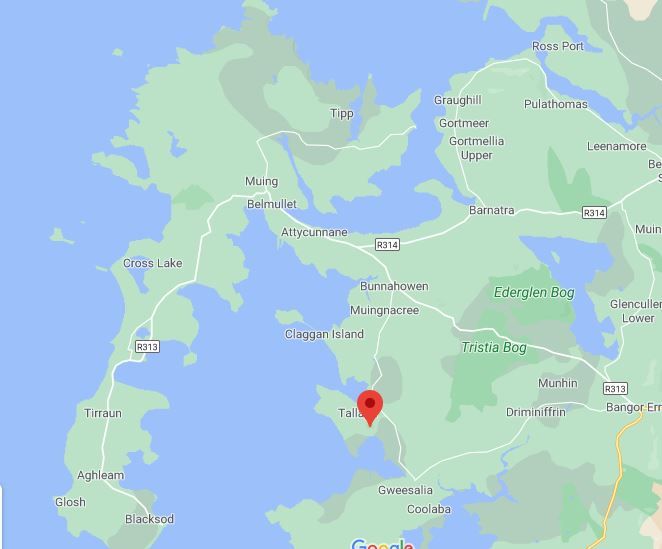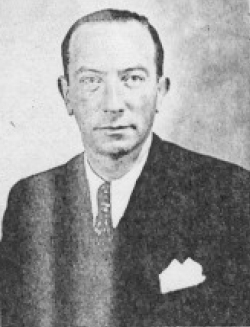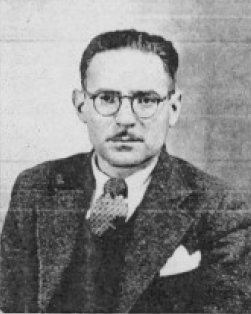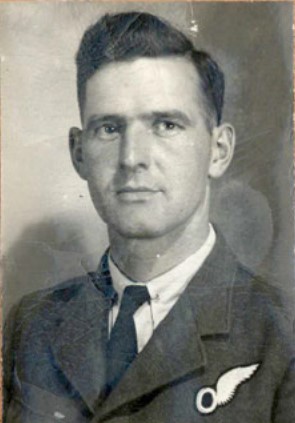North American Mitchell, 31 January 1944
On the afternoon of the 31st January, 1944, the rural
tranquility of Doolough townland, near Geesala in the west of
County Mayo, Ireland was interrupted with the arrival of a
stricken bomber of the Royal Air Force.

The Irish Army report on the landing, G2/X/1278, records that
the landing took place around 18:45 in the evening. The
landing appears to have been made with landing gear down which
caused the nose landing gear to dig in and the aircraft tipped
nose up. The nose and propellers of the aircraft were
damaged because of this. The guns on the aircraft were
recorded as being sealed and no ammunition was found on
board. This information would be sought by the government
in order to allow them make the determination that the aircraft
was not on an active combat operation and thus made the crew
eligible for release.
A twenty eight day salvage operation by the Irish Army and Air
Corps followed, one that was carried out in conjunction with the
similar salvage of an American
B-17 Flying Fortress nearby on the Mullet peninsula.
The presence of an RAF salvage crew at the Doolough site is
noted by the Irish army report. The Operations Record Book
of the RAF's 226 Maintenance Unit recorded the following entry
around that time:
Feb 6th 1944 – A detachment of 1 Sgt and 11 men proceeded to
Bellmellet, Co Mayo , Eire to dismantle and transport under
the supervision of F/Lt Moore of HQ, RAF NI, a Mitchell and
Fortress aircraft which had force landed.
Damage caused to the farmers field by the recovery machinery is
noted in the report as compensation would have been
sought. It was also noted that a young local man had made
off with a bomb rack from the aircraft.
The crew of three was noted to have been in civilian clothing
and were taken to Healions Hotel in Belmullet for the night and
handed over the border on the day after the landing at 22:00
hrs. They had small injuries and were looked after by
local Red Cross and Jubilee nurses. They reported to Irish
Army officers that they were running low on fuel and elected to
make a landing.
 Charles Louis LeChevalier was a pilot well
known in French aviation circles after the war, and much is
written about him and indeed, by him, in French.
Charles Louis LeChevalier was a pilot well
known in French aviation circles after the war, and much is
written about him and indeed, by him, in French.
He was born in October 1903 near Avranches,
 The Co-pilot was Etienne
Nemes, a French civilian contractor. He had been
born in 1914 in Budapest and at the time of the crash, his
wife's address was given as Casablanca, Morrocco.
The Co-pilot was Etienne
Nemes, a French civilian contractor. He had been
born in 1914 in Budapest and at the time of the crash, his
wife's address was given as Casablanca, Morrocco.
He is well known in French aviation circles, and sources there
indicate that he made efforts to escape from Vichy North Africa
in a stolen aircraft, only to find himself imprisoned. He
escaped from prison with the aid of his wife and made his way to
England and from there to Montreal where he joined Ferry Command
in June 1943. He was crewed on countless aircraft ferry
missions in the following two years, taking him to Europe,
Africa and as far as India.
 The aircraft's navigator was a Winnipeg, Canada
born man, Norman Hugh Alexander Scott. Serial
numbers R.93254 and J.45239)
The aircraft's navigator was a Winnipeg, Canada
born man, Norman Hugh Alexander Scott. Serial
numbers R.93254 and J.45239)
Norman Born 29 January 1915. Enlisted in Winnipeg, 27 February
1941.
Norman had begun pilot training in 1941 but by the end of the year he had been transferred to undergo navigation training as an observer. This training brought him through 5 Air Observers School and 5 Bombing and Gunnery School in Canada before graduating on 24 March 1942.
He is shown as making first ferry flight with Ferry Command,
August 1942 (Hudson FK471, which he seems to have accompanied as
far as Kartoum).
He was posted to the United Kingdom in October 1944, but it is
not known in what capacity he served while in the UK. He
was repatriated 3 December 1945 and retired 18 January 1946.
He passed away on the 19 May 2000 in Winnipeg. His
obituary recorded the following biographical information:
He married Elsie Ruth Tyler on June 3,
1939 at St. Thomas Anglican Church and they raised their
family in Winnipeg. He joined the RCAF during the Second
World War (1940-1946) and became a Pilot Officer, Navigator
with Ferry Command. He served in England, France, Italy,
North Africa and the Bahamas. Following release from the
RCAF, he returned to the CP Express; worked with the
Government of Manitoba, Highways Department, and in his
retirement years served as Chairman of the License
Suspension and Appeal Board for the province. During this
time he held various positions in MGEA and and later serving
as President of MGREA. He was an active supporter of the New
Democratic Party in the Burrows constituency for many years.
Norm was a 49 year member of the Royal Canadian Legion,
Branch No. 2, serving as President in 1961-1962.
Compiled by Dennis Burke, from Dublin and Sligo, 2021, with the aid of all those listed above. If you have information on any of the people listed above, please do contact me at dp_burke@yahoo.com
